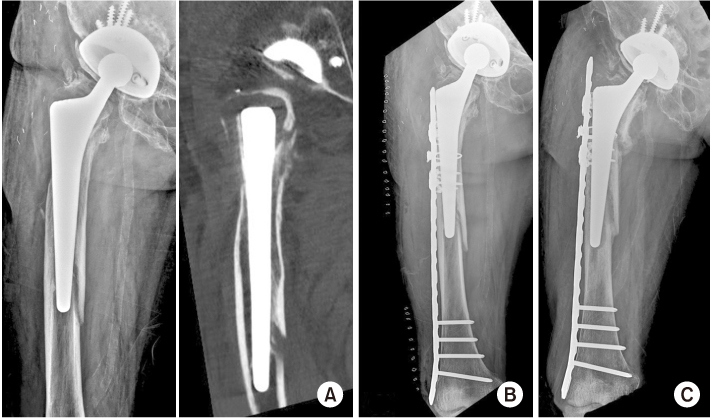Articles
- Page Path
- HOME > J Musculoskelet Trauma > Volume 33(1); 2020 > Article
- Review Article Treatment of Periprosthetic Femoral Fractures after Hip Arthroplasty
- Jung Hoon Choi, Jong Hyuk Jeon, Kyung Jae Lee
-
Journal of Musculoskeletal Trauma 2020;33(1):43-51.
DOI: https://doi.org/10.12671/jkfs.2020.33.1.43
Published online: January 31, 2020

- 992 Views
- 6 Download
- 0 Crossref
- 0 Scopus
Abstract
Although the incidence of postoperative periprosthetic femoral fractures after hip arthroplasty is expected to increase, these complex fractures are still challenging complications. To obtain optimal results for these fractures, thorough clinical and radiographic evaluation, precise classification, and understanding of modern management principles are mandatory. The Vancouver classification system is a simple, effective, and reproducible method for planning proper treatments of these injuries. The fractures associated with a stable femoral stem can be effectively treated with osteosynthesis, though periprosthetic femoral fractures associated with a loose stem require revision arthroplasty. We describe here the principles of proper treatment for the patients with periprosthetic femoral fractures as well as how to avoid complications.
Published online Jan 23, 2020.
https://doi.org/10.12671/jkfs.2020.33.1.43
Treatment of Periprosthetic Femoral Fractures after Hip Arthroplasty
Abstract
Although the incidence of postoperative periprosthetic femoral fractures after hip arthroplasty is expected to increase, these complex fractures are still challenging complications. To obtain optimal results for these fractures, thorough clinical and radiographic evaluation, precise classification, and understanding of modern management principles are mandatory. The Vancouver classification system is a simple, effective, and reproducible method for planning proper treatments of these injuries. The fractures associated with a stable femoral stem can be effectively treated with osteosynthesis, though periprosthetic femoral fractures associated with a loose stem require revision arthroplasty. We describe here the principles of proper treatment for the patients with periprosthetic femoral fractures as well as how to avoid complications.
Fig. 1
(A) Preoperative radiograph and computed tomography scan show a periprosthetic femoral fracture after revision total hip arthroplasty. The surgeon decided the stem to be stable (Vancouver type-B1). (B) Indirect reduction with locking plate fixation was applied for this patient. Note that a locking attachment plate and cables were used for additional stability. (C) Postoperative radiograph at three months shows subsidence of the femoral stem (Vancouver type-B2).
Fig. 2
Anteroposterior radiographs of the femur obtained at prefracture (A) and post-fracture (B). Note that the distance between the tip of the greater trochanter and stem shoulder was increased after the periprosthetic fracture (stem subsidence). This implies the stem is unstable.
Fig. 3
(A) The preoperative radiograph shows periprosthetic femoral fracture. This stem is classified as type 1, which means it is a single-wedge proximal coated stem. Note that the fracture itself did not involve the proximal coating area. Open reduction and internal fixation with a locking plate (absolute stability) was applied (B) and the radiograph obtained at 5 years after fixation (C) shows a well-united fracture site and stable stem.
Fig. 4
Postoperative radiographs shows use of a blunt tip screw (arrow) to avoid cement mantle damage.
Fig. 5
(A) A 79-year-old female sustained a Vancouver type-AG fracture (arrows) after a fall. (B, C) A greater trochanteric fragment was displaced and recurrent dislocation had developed. (D) Open reduction and internal fixation with a claw plate was applied.
Fig. 6
Anteroposterior and lateral radiographs of the femur show a long looking plate was used for the Vancouver type-B fracture. Six unicortical screws and two cables were applied on the proximal femur for achieving sufficient stability.
Fig. 7
(A) Preoperative radiographs of the femur show a minimally displaced Vancouver type-B fracture. (B) Indirect reduction with plate osteosynthesis (relative stability) was used for the fixation.
Fig. 8
(A) Preoperative radiograph of the femur shows a Vancouver type-B2 fracture. (B) Postoperative radiograph shows revision of the femoral stem with using a prophylactic cable (arrow).
Fig. 9
(A) A 45-year-old male sustained a comminuted Vancouver type-C fracture after a traffic accident. (B, C) Minimally invasive plate osteosynthesis with a locking plate was used and the radiograph demonstrates good healing of the fracture.
Table 1
Vancouver Classification of the Postoperative Periprosthetic Femoral Fractures
Financial support:None.
Conflict of interests:None.
References
-
The Korean Hip Society. Textbook of the hip. 2nd ed. Seoul: Koonja; 2019. pp. 668-679.
-
-
Otero JE, Martin JR, Rowe TM, Odum SM, Mason JB. Radiographic and clinical outcomes of modular tapered fluted stems for femoral revision for Paprosky III and IV femoral defects or Vancouver B2 and B3 femoral fractures. J Arthroplasty. 2019 [doi: 10.1016/j.arth.2019.11.039][epub].
-

 E-submission
E-submission KOTA
KOTA TOTA
TOTA TOTS
TOTS












 PubReader
PubReader Cite
Cite

